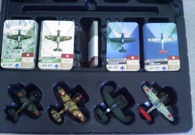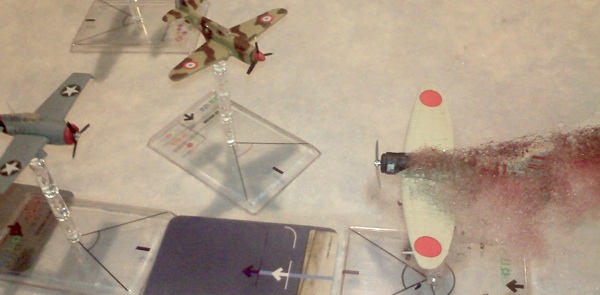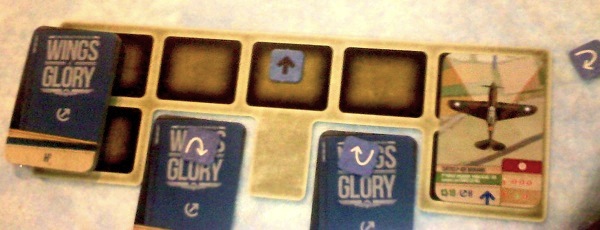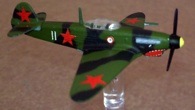Wings of Glory: World War II – Miniatures Game Review
 Wings of Glory – World War II. Miniatures game review. Publisher: Ares Games. SRL Designers: Andrea Angiolino and Pier Giorgio. Starter set $69.95; boosters $10–$15 each.
Wings of Glory – World War II. Miniatures game review. Publisher: Ares Games. SRL Designers: Andrea Angiolino and Pier Giorgio. Starter set $69.95; boosters $10–$15 each.
Passed Inspection: Gorgeous miniature airplanes, easy-to-learn game system, well-written rules with plenty of examples. Backward compatible with Wings of War. Fun to collect!
Failed Basic: Some curious rules omissions. Starter set only includes 4 airplanes. Expensive to collect.
Wings of Glory is the successor to the extremely successful line of Wings of War World War I and World War II cards-and-miniatures games, which was first published in Italy in 2004; the English-language version was sold in the U.S. by Fantasy Flight Games. The original World War I series and the first World War II game, Dawn of War, were reviewed on Armchair General in 2008, so ACG thought it appropriate to give players the skinny on what to expect from Wings of Glory.
{default}Wings of War originated as a card game in which each card represented one airplane, anti-aircraft gun or balloon, but it evolved into a miniatures air-war game; players can purchase "booster" packs with individual airplanes or even large models of observation balloons. Unlike "collectible minis" systems like the Axis & Allies Miniatures game, the WoW/WoG minis were never randomly packaged, with "rare" miniatures in some boxes. You knew exactly what you were getting before you plunked down your money.
In 2011, the Italian publisher of Wings of War, NG International, went out of business, and enthusiasts moaned that they might never again be able to purchase expansions. Then, late in 2011, Ares Games of Italy announced it had not only picked up the product line but had kept the same creative team that was behind the original products. (See the accompanying interview with Roberto Di Meglio, editor and product manager for Ares Games—Ed.)
 Early 2012 saw the release of the new Wings of Glory – World War II Starter Set and boosters, with more planes promised. World War I starter sets and airplanes are also being released later this year. Wings of Glory is fully backwards compatible with Wings of War, and the airplanes models are of the same scale (1:200) and high quality.
Early 2012 saw the release of the new Wings of Glory – World War II Starter Set and boosters, with more planes promised. World War I starter sets and airplanes are also being released later this year. Wings of Glory is fully backwards compatible with Wings of War, and the airplanes models are of the same scale (1:200) and high quality.
Like its predecessor, Wings of Glory is a tactical airplane combat system. Both the World War I and World War II game use the same basic system but with a few differences to accommodate the speed differences between 1917–1918 airplanes and those that flew in the 1940s.
Game play is simple. Players pick the airplanes they wish to fly. Each plane is rated for speed and maneuverability, weapon power, climb and diving rates, altitude ceiling and hull points. The speed and maneuverability are assigned to each plane as a letter A, B, C, etc., and each letter corresponds to a maneuver card deck; each maneuver deck has cards for flying straight, side-slipping left and right, turns, climbing, diving, Immelmanns, etc. In the World War II game, most maneuvers can be performed at either normal speed or high speed.
The clear base of each airplane miniature is marked with a blue arrow in the front-center of the base. The player lays the chosen maneuver card for the round in front of the base, and then moves the base so that the arrow on its bottom lines up with the arrow on the card. It’s that simple—no need for hex maps. The game can be played on a card table! Also, there are no "player turns," per se; movement is pre-planned and all players’ maneuver cards for a round are revealed at the same time, so the feel is much more like a real dogfight.
When an enemy airplane ends a round within range of an opponent’s guns, the distance is measured to see if the firing is at short or long range, and then damage counters are drawn to see what occurs. The damage counters are color-coded to correspond with the types of guns on the firing player’s airplane: .30-caliber, .50-caliber, 20mm cannons, etc. The player being attacked draws a number of tokens of the specified color. If the numbers on the back of the tokens are greater than zero, the player subtracts that amount of damage. When damage equals a plane’s total points, it is shot down.
Special damage may result, such as fire, engine hits, pilot hits, etc. When a fire token is drawn, for example, the player must draw damage counters each turn for up to six turns, applying additional damage each time. One of the pictures in this review (below) shows a Japanese Val bomber (from the original Wings of War set) that was set on fire by a lucky hit from a P40 (from Wings of Glory). Luckily for the Val player, he primarily drew zeros and ones for damage, ended up surviving the engine fire and successfully bombed his target.

Just a flesh wound! The Val’s in trouble but managed to complete its mission.
The great thing about the way the damage system works is that the firing player doesn’t know how much damage he actually inflicted, adding greatly to the fog of war. The player who took the damage may say, "You see a few pieces flying off my plane," or "My rudder now has a large hole in it," or even "I just blew up!"
The information above is all a player really needs to know to fly and fight! The basic rules are contained within seven pages, and there are advanced and optional rules for altitude, climb and dive rates, bombing, campaigns and pilot experience, flak and more. Regarding altitude, the miniatures sit on four-section posts above their bases, and post sections are removed to show different altitudes; therefore, a miniature sitting atop two sections is two levels below an airplane on a four-section post. All of this is in keeping with the original rules.
The game is a blast. I regularly play with a group of six people and I’ve refereed a World War I game with over 20 players. An average game with five or six people usually takes less than an hour. The game can be played solitaire but loses much of its fog-of-war charm.
Aesthetic changes aside, there are few differences between the Wings of War rulebook and the Wings of Glory rules—though strangely, the original rules for drop tanks and detailed rules for level and dive-bombing are not included in this edition. A simple dive-bombing system is included in some of the scenario special rules. The full-color rules are logically laid out and include plenty of examples.

Players’ control cards have a new look, but other than aesthics, little has changed on them.
The four miniature airplanes included in the new Wings of Glory – World War II Starter Set are the P-40 Warhawk, the Russian Yak-1, the Japanese Kawasaki Ki-61 and the Italian Re. 2001 Falco. The miniatures are beautiful, especially the Ki-61. The P-40 included is in the colors of the Free French. A P-40 painted in the familiar Flying Tiger pattern is available as a booster, as are different paint schemes for all the other planes. Upcoming releases include the German He111 bomber and the American B-25 Mitchell; the original game never offered larger, level bombers like these.
My only complaints are minor. Background detail on each plane would have been a nice addition. There does not seem to be much difference in the performance of the planes, which appears to fly against (no pun intended) the available data on each type. Also, as with the original WoW WWII game (called Dawn of War because it focused only on the war’s first years), there are no mid- to late-war airplanes such as the P51, Corsair, Fw190, Me262, etc. The speed difference between early to mid-war planes and mid- to late-war planes has posed a problem in the past, but hopefully Ares will address the issue.
 Financially, it can be difficult to put together large squadrons of airplanes for the game. Aside from the cost of the starter, the boosters cost around $10–$15 for one airplane, its base and its associated maneuver cards. The nice thing is that the boosters are not blind draws ala Axis & Allies, Heroclix, et al, so if the player wants to focus on putting together a squadron of Flying Tigers, he or she can purchase only that type of P40.
Financially, it can be difficult to put together large squadrons of airplanes for the game. Aside from the cost of the starter, the boosters cost around $10–$15 for one airplane, its base and its associated maneuver cards. The nice thing is that the boosters are not blind draws ala Axis & Allies, Heroclix, et al, so if the player wants to focus on putting together a squadron of Flying Tigers, he or she can purchase only that type of P40.
Overall, Wings of Glory is a beautiful new edition of a classic air-war game. Kudos to all at Ares Games for keeping this franchise flying—and for keeping in the new edition everything that made the original so much fun!
Armchair General Rating: 90 %
Solitaire Rating: 2 out of 5 (5 is completely suitable for solitaire play)
Click here to read Rick Martin’s interview with Roberto Di Meglio, editor and product manager for Ares Games.
About the Author
A college film instructor and small business owner, Richard Martin has also worked in the legal and real estate professions, is involved in video production, film criticism, sports shooting and is an avid World War I and II gamer who can remember war games that came in plastic bags and cost $2.99 (he’s really that old)!


Great review. Will be getting the deluxe set at my local hobby store soon. Would have liked to seen photos of the new movement cards though. But over all a great review.
Thank you. The new movement cards are not that much different from the old ones actually. Just a few changes.
Played both sets of games, the WW-1 series matched well to the performance of each plane, you can tell the difference. However, as nit picked already as being a possible issue, it actually IS a major issue in the WW2 game set. In playing the Japanse Vs American fighter, the plane capabilities have been normalized, meaning little difference in manner of flying. In actual fact, the Zero was very highly apt in flight, giving the Americans serious problems in dog fights. A way around this is to change the card set for the Zero to A set, which now gives the ability for very tight turning circle .. wish the data files of planes in this WW2 set had been properly investigated. In looking to the difference to the Hurricane Vs Spitfire, the ability of taking damage is all wrong, as Hurricane could take a lot more pounding than a Spitfire !! It is these basics that let the series down.
Beautifully made of course, so Ares please, please do a make over !
I’m very interested and would like to know the scales of both WW1 and WW2 ‘planes.
Hope you can help.
Harry, the WWI planes are 1:144 and the WWII planes are 1:200.
Muito interessante